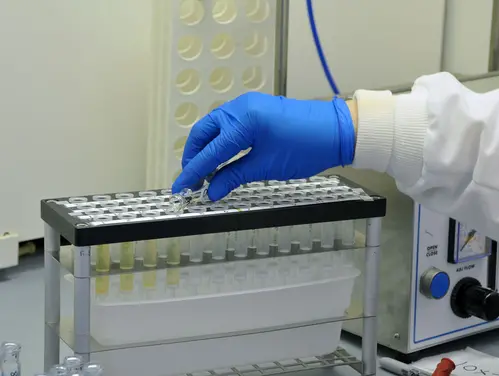On this page...
Toxicology is the fundamental science of poisons. A poison is generally considered to be any substance which can cause severe injury or death as a result of a physicochemical interaction with living tissue. However, all substances are potential poisons since all of them can cause injury or death following excessive exposure.
The name forensic toxicology implies that the science has a legal purpose as its basis. Forensic Toxicology is defined by the American Board of Forensic Toxicology as the study and application of toxicology to the purpose of the law.
2026 Blood & Urine Drug Detection Levels for Randox Screening
Blood & Urine Drug Detection Levels for All Tox Drug Submissions
Blood & Urine Drug Detection Levels for Sex Assault and Special Request Tox Submissions
Blood & Urine Drug Detection Levels for Special Request Tox Submissions Only
Back to top
BLOOD & URINE DRUG ANALYSIS
BLOOD
This laboratory is working to develop further confirmatory analysis capabilities for drugs in blood and will list any additional compounds in the attached document.
Blood screening is done using an immunoassay biochip array from Randox Laboratories called “DoA ULTRA WB”.
For positive screens not confirmed by this laboratory, it is recommended that the sample be sent to a private laboratory for confirmation. Arrangements and expenses for sending the sample to a private laboratory must be made by the submitting agency. The DCI Laboratory website has a list of Private Laboratories Testing which may be used for these analyses.
URINE
The detection of drugs in a urine sample is determined by initial screening or presumptive tests. These tests target compounds in a drug group rather than specific drugs. Following a positive screening result on a sample, a second confirmatory test is performed. This second test uses a different analytical technique to identify a specific drug compound.
Back to topALCOHOL & INHALANT ANALYSIS
Alcohol analysis is performed on either blood or urine.
URINE
Urine alcohol analysis samples MUST be in a gray stoppered tube with 100 mg of sodium fluoride.
January 1, 2008 - Alcohol Policy Click to read Policy Statement
Click on the video above to view the training video, and then click here to download the form (PDF / Word) and submit it to breathalcohol@dps.state.ia.us.
Two results (grams/67mL) (grams/57mL) are reported when the urine sample is a first or random void. One result (grams/67mL) is reported when the urine sample is a second void.
Blood and urine ethanol (alcohol) limit of detection (LOD) is 0.010 g/100mL. Blood and urine ethanol (alcohol) limit of quantitation (LOQ) is 0.020 g/100mL.
*As of April 2024, the laboratory is no longer capable of performing retrograde extrapolations on urine alcohol cases.
INHALANT ANALYSIS
- The laboratory tests for inhalants in both blood and urine.
- Inhalant testing for should be requested in the case comments section upon submission.
- The biological sample can be placed in any type of evidence container (bottle or gray topped tube).
- The most common inhalant the laboratory detects and reports out is Difluoroethane.
- Some examples of inhalants the laboratory detects are: *Sevoflurane, Methanol, Toluene & Acetone.
*Sevoflurane is an anesthetic and may be given to a subject by medical personnel.
- Inhalants detected on a person’s breath may cause an “INTERFERENCE DETECTED” response from the DataMaster.
APPROVED BLOOD AND URINE KITS:
- Tri-Tech @ 800.438.7884
UC-1 (one bottle)
BA-2 (two tubes)
PM-3 (one bottle & two tubes) - Forensic Source @ 800.852.0300
#3010 - (one bottle)
#BU-3 - (one bottle & two tubes) - Lynn Peavy @ 800.255.6499
#03905 or equivalent - Arrowheads Forensics @ 800.953.3274
A-BAU-10 (one bottle & two tubes)
A-USCK-10 (one bottle)
A-BAS-10 (two tubes) - Sirchie @ 800.356.7311
BUK200 (one bottle & two tubes)
BUK100A (one bottle & two tubes)
BSC100A (two tubes) - Drugsmart containers or equivalent
(For drug analysis only) - Other kits that would be equivalent to the kits mentioned above.
PRIVATE LABORATORIES TESTING
Should you have specific needs for toxicology testing beyond the current capabilities of our laboratory, we recommend that you contact the following private laboratories:
NMS Labs
www.nmslabs.com
AXIS Forensic Toxicology, Inc.
http://www.axisfortox.com/
Great Lakes Laboratories
https://gl-labs.com/
This list is provided for your convenience and is not an endorsement of any lab.

